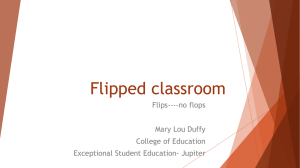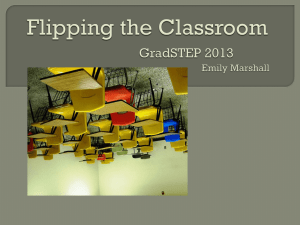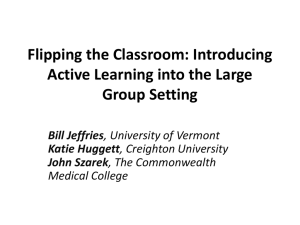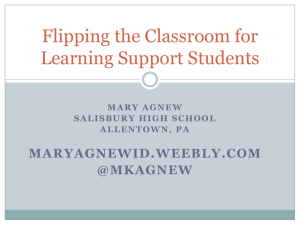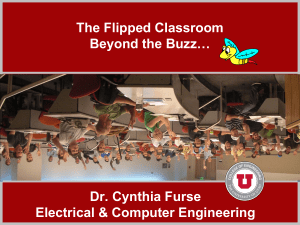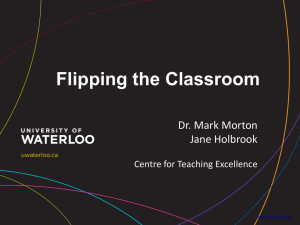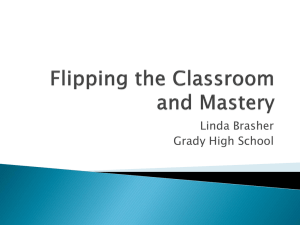Flipping the Classroom
advertisement
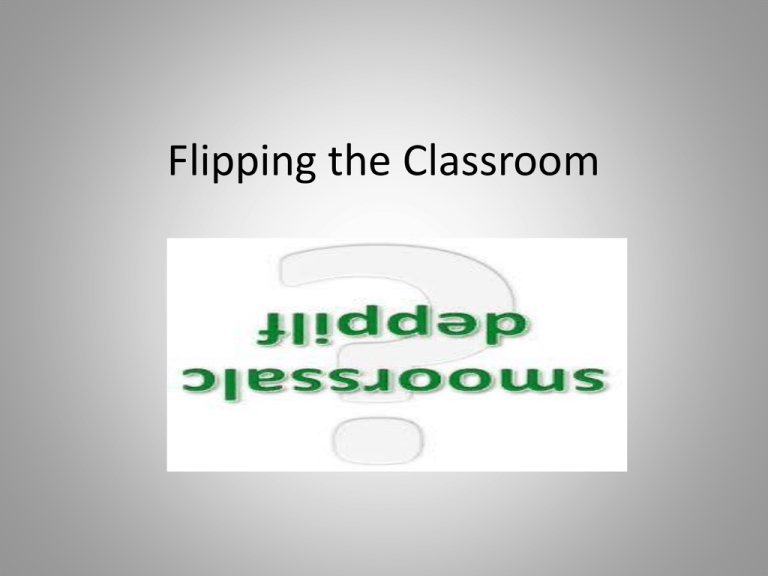
Flipping the Classroom Presenter Information • • • • Mary K Abkemeier Fontbonne University Chair, Department of Math and CS Mary.abkemeier@fontbonne.edu What does it mean to “flip” a class? Flipping the classroom refers to swapping classroom lecture time for hands-on practice time. Flipping is not new, but with the current available technologies, flipping is easier than it used to be. There are many ways to flip a classroom, yet the main elements are the same: The instructor uses technology is some way •YouTube •PowerPoint •Recorded lectures •linked sources, etc to acquaint students with the course concepts and content before they arrive in class. He/she then uses class time to help students gain a deeper understanding of the material. What does it mean to “Flip?” What is typically given as homework is done in class with the assistance of the teacher. Benefits of flipping -1 • Implementing a flipped classroom enables more focused teaching and learning to take place in the classroom. • Moving the lecture to the homework realm makes room for one-on-one classroom experiences. Benefits of flipping -2 • Passive, one-way lecturing is eliminated as the only means of teaching. • More interaction between student and teacher occurs during class time. • Classroom time is used to solve problems and apply to other contexts (the application of higher order thinking skills). Benefits of flipping -3 • Flipping the classroom also makes differentiating instruction based on students’ needs easier because everyone does not necessarily need to do the same task in class. Benefits of flipping - 4 • Video lectures can be edited, polished and rerecorded. Students can pause, replay and watch lectures repeatedly. Benefits of flipping - 5 • Instructors can devote time to helping students develop synthesis and explore applications during class time. • Students can receive direct faculty input on those segments of the material that have historically been the most difficult or ambiguous. The Flipped Classroom is NOT: • • • • • • Just online videos About replacing teachers with videos An online class Students working without structure Students working in isolation Students spending the entire class online The Flipped Classroom IS: • A means to increase teacher contact time • An environment that increases student responsibility • The blending of direct instruction and constructivist learning • A class where all students are engaged • A class where absent students won’t fall behind • A class where students are engaged in their learning Concerns • Students with no internet access. – Try your best to accommodate these students by burning a CD or use other ways to get the information to them. What if student does not do outof-class work? • Age-old problem, right? • You might pair an unprepared student with a prepared one. But do not reteach the “outside-the-class materials.” • Consider an online quiz or one students take immediately upon arriving in the classroom. • Require students to summarize what they learned. • I used Voice Thread. Details to consider • Flipping does not work if you use videos that are too long. Keep videos to about 10 minutes. • Make your videos engaging with multimedia. • You might – Narrate a PowerPoint – Use Jing or Screencast-o-matic Planning • Planning and Preparation can make or break a flipped classroom. • You cannot decide one week before classes begin to flip your class. • The time involved is similar to designing an online course. Planning Model for Flipped Classes • • • • Introduce the task Out-of-Class Task Assess Learning In-Class Activities Introduce the task • Maximize student readiness for the in-class activities. • Clearly explain expectations for students. • Indicate the amount of time needed to complete the out-of-class activities Out-of-Class Task • Carefully choose the media for the online part. • You can • Create your own materials • Narrate your own PowerPoints • Screen cast some problems • Send students to web sites Assess Learning • Before the in-class part somehow assess the learning • I use Voice Thread • You can – Give online quiz – Give short quiz at beginning of class – Ask for one points that is still confusing In-class activities • Insist on activities that foster – Peer-to-peer – Instructor to student • Can be even more challenging than the ones you might ordinarily assign Let’s look at my Calc III class • Http://bblearn.fontbonne.edu Take a look at my narrated PowerPoint shows Some You Tube videos – some are Kahn Solutions to some problems using my iPad Voice Thread Comments from Fall 13 College Algebra • I liked being able to pause the videos and catch up on my note taking. • I liked getting homework help during class time instead of trying to find a time to meet with you. • I liked getting homework help right at the time I was working the problems. More…. • I was amazed at how much this method worked for me. I had a D from a local CC and managed to earn an A this time. This time I think I learned the concepts. • I think this is the only was a course should be taught. • I personally did not like the “flipped” classroom. Teachers need to teach me the math and not a computer. Comments from Calc III Questions and/or Comments Some resources • Five Best Practices for flipped classroom • Flipped Professional Development for Teachers • Resources – flipped learning • 8 great reasons to flip your class • Flipped Learning network- homepage
